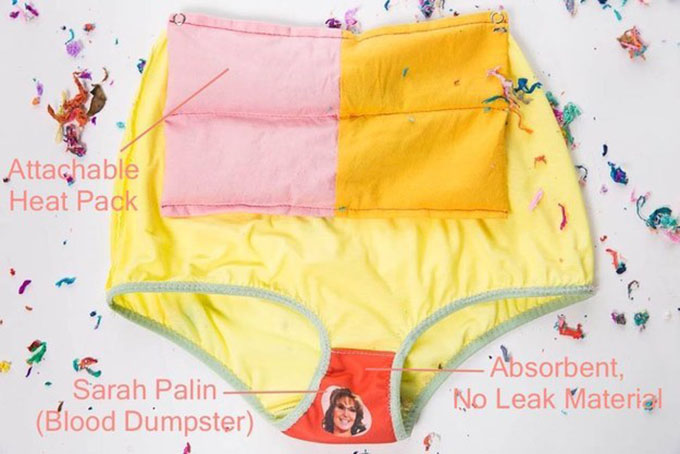In an era where political discourse often treads the fine line between the absurd and the deeply personal, a new product has emerged that intriguingly intertwines fashion with fierce political statement: period underwear emblazoned with the images of pro-life politicians. This provocative item boldly challenges societal norms regarding menstruation and reproductive rights, making it a fascinating focal point for discussion. It invites us not only to ponder the implications of such a product but also to confront the entrenched systems of ideology that govern our bodies and choices.
The contemplation of the interplay between fashion and sociopolitical issues has a rich history. This particular piece of apparel seeks to harness the menstrual cycle—a natural biological process—while simultaneously presenting a satirical critique of the political entities that oppose women’s autonomy over their reproductive health. Its very existence encourages a reflective dialogue about the implications of wearing political figures on one’s inner lining, thrusting bodily autonomy into the marketplace of ideas.
In this exposition, we shall delve into the peculiarities that surround this garment, dissect its cultural significance, and reflect on its audacious interplay with feminist principles. We will traverse the thriving landscape of feminist fashion, the politics of menstruation, and the boundary-pushing domains of satire and commodification in contemporary society.
The Unfurling of Menstrual Politics
The very notion of period underwear is itself an embodiment of the broader shift toward menstruating individuals reclaiming their experience. Traditionally shrouded in stigma and silence, menstruation remains a taboo subject in many cultures. However, the advent of period-friendly garments represents a reclamation of narrative: a celebration of the femaleness that society has for too long relegated to the shadows.
By donning underwear that features pro-life politicians, wearers invite scrutiny and conversation around a sector of America’s political landscape that arguably thrives off the regulation of women’s bodies. The juxtaposition is jarring—how does one genuinely merchandise political figures within an intimate context? It begs the question of how menstrual experiences are perceived by those in power and what they convey about personal agency and bodily autonomy. The product serves as a canvas upon which users can paint their dissent, quite literally bleeding their resistance onto the very figures who would dictate their choices.
Wielding Humor as a Weapon
Satire has long been employed as a vehicle for social critique, illuminating the absurdities of power dynamics. The creators of this novelty piece extend the weaponization of humor into the realm of clothing, transforming an everyday item into a bold statement piece. In doing so, they effectively challenge the consumer to evaluate their own relationship with the political climate surrounding reproductive rights.
Humor, especially when it touches on sensitive subjects, operates in a nuanced capacity. It can defuse tension, provoke thought, and encourage dialogue where silence once prevailed. The lighthearted spirit imbued in this unusual item invites individuals from all walks of life to engage in discussions that may otherwise remain unaddressed. It presents the troubling reality around women’s rights by turning a bodily function into a spectacle for amusement and examination.
This approach resonates well within the tradition of feminist activism—whether it be the appropriated aesthetics of riot grrrl punk or the reclamation of derogatory terms. In establishing a sense of camaraderie among those who owned or wore the product, it cultivates a collective identity steeped in shared experiences of marginalization and resistance.
Beyond the Chuckle: A Call to Action
While amusingly bold, the dialogue surrounding this period underwear duels not only with humor but also with a salient call to activism. The juxtaposition of menstrual realities against a backdrop of political imagery serves as a reminder to patrons of their civic duties. It implores individuals to reflect on how the implications of legislation directly impact their lives and reproductive choices.
The intimate nature of the underwear also highlights the dichotomy between public perception and private experience. It prompts the wearer to consider how intimate issues are often dismissed in the public forum. The product enshrines a paradox; despite the personal nature of menstruation, society’s legislation surrounds it—often with little regard for those directly affected.
Additionally, the unique discourse fostered by the existence of such a garment aligns with an urgent necessity: raising awareness about reproductive rights, the implications of pro-life legislation, and the necessity of intersectional feminism. The marketing strategy does not just serve the consumer; it challenges them to partake in a larger movement, one that seeks to demystify menstruation while advocating for solid legislative changes.
The Merchandising of Dissent
As strange as it may seem, the commodification of cultural critique is not a novel concept. The blending of consumerism with activism presents an intriguing dynamic, wherein products not only fulfill a practical need but also serve as tools for larger conversations. This friction between practicality and purpose invites critique while simultaneously challenging traditional notions of commerce.
The emergence of such products raises essential questions regarding ethical consumption and the potential repercussions of commodifying sociopolitical issues. To what extent does the purchase of this underwear contribute to meaningful discourse or societal change? Or does it risk becoming merely another fad, a trend that fades as quickly as it emerges?
Questions like these propel meaningful investigations into consumerism, identity, and social responsibility. Engaging with these products necessitates understanding one’s autonomy as both a consumer and a political entity—it urges individuals to tread thoughtfully within their choices while navigating their identities and beliefs.
Empowering The Next Generation
Lastly, as society advances toward greater inclusivity and understanding of biopolitical issues, products like this period underwear serve an additional purpose: they empower the next generation. By fostering conversations regarding menstruation and reproductive rights, they dismantle the barriers constructed around these topics. They do not merely serve to provoke thought; they open up avenues for education, awareness, and advocacy, thus nurturing a more informed populace.
In stripping away the stigma surrounding menstruation and juxtaposing it against political imagery, this unique garment makes an unmistakable statement: the personal is political, and every period can be a protest. This playfully audacious approach propels conversations into the mainstream, inviting each wearer to embody resistance and to transcend the limitations of historical silence.
In conclusion, this whimsical yet poignant product encapsulates the entanglement of identity, consumerism, and political critique. It reflects a distinctly contemporary approach to activism—one that honors humor while embodying fierce advocacy. As we ponder the implications of wearing pro-life politicians inside our underwear, perhaps the most significant question remains: what does it take for society to bleed, figuratively and literally, for the cause of women’s rights? Here lies a challenge for the present generation, daring them to unearth the depths of their ideology and engage with their body politics while dressed in defense of their agency.





























